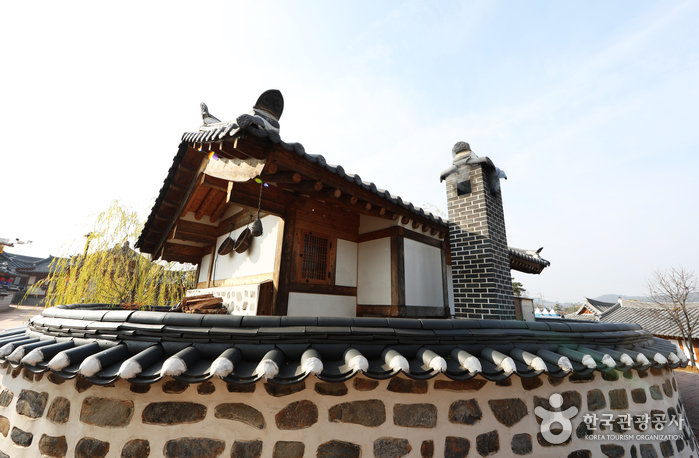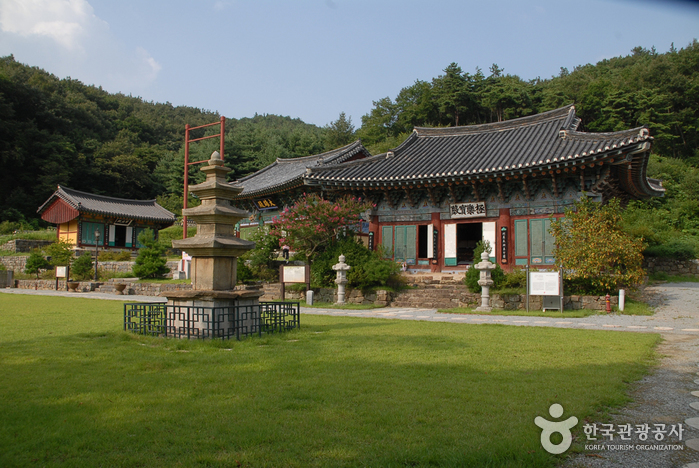Solbat Mukjip (솔밭묵집)
13.9Km 2024-02-14
51 Gwanyong-ro, Yuseong-gu, Daejeon
Solbat Mukjip is a restaurant celebrated for its 40-year tradition in crafting dotorimuk (acorn jelly salad), a culinary specialty of Daejeon. The city is so famed for its acorn jelly that it hosts an acorn jelly village. The restaurant's standout dish is chaemuk (chilled acorn jelly and rice soup), a delightful blend of chopped acorn jelly immersed in broth and garnished with sour chopped kimchi, sesame oil, laver flakes, and roasted sesame powder. The combination of the nutty acorn jelly salad with the tangy broth creates a uniquely delicious flavor. Additionally, the thinly batter-fried acorn jelly is a popular choice. This dish is served with a side of refreshing radish water kimchi and other accompaniments.
Jeju Bakdonga (제주박돈가)
14.0Km 2024-02-23
52 Gwandeul 2-gil, Yuseong-gu, Daejeon
Jeju Bakdonga is a restaurant renowned for its Jeju Island black pork, with the signature dish being heukdwaeji ogyeopsal gui (grilled skin-on black pork belly). Known for its juicy and chewy texture, the pork is served with ample portions of green onion kimchi and a refreshing green onion salad. For an authentic Jeju experience, guests are encouraged to try dipping the meat in salted anchovies, a local custom. Additionally, the restaurant serves a satisfying beef hangover soup, vegetables for wraps, garlic, and a selection of sauces. The kimchi jjigae, a highlight of their lunch special menu, is also highly recommended.
Baekje Experience Center (백제오감체험관)
14.0Km 2024-01-08
30 Gomanaru-gil, Gongju-si, Chungcheongnam-do
The Baekje Experience Center offers a rich array of activities that allow visitors to engage with the history they have observed at the nearby ancient tombs in Songsan-ri and the Gongju National Museum in a tactile manner. This center features eight themed halls across the first basement, and the first and second above-ground floors, offering interactive and gaming programs designed to stimulate all five senses. Activities such as rubbing pattern experience and luminous stamps allow visitors to learn about and appreciate the culture and history of Woongjin Baekje in an intuitive way. One of the center’s highlights is the Window of Sympathy in the first-floor lobby. This impressive two-story panel changes its color in response to sound and touch, promising to attract significant attention from tech-savvy visitors. It showcases content that guests have captured within the center and shared on social media, complete with hashtags. Additionally, the Window of Creation on the same floor offers a unique creative outlet. Here, visitors can color Baekje-era relics with crayons. These artworks are then transformed into graphic mapping images on the wall via a scanner, allowing for a personalized and immersive historical experience.
Shanghai Yangkkochi (상하이양꼬치)
14.0Km 2024-03-28
72-9 Gwandeul 2-gil, Yuseong-gu, Daejeon
Shanghai Yangkkochi specializes in yang kkochi (lamb skewers). The restaurant's signature yang kkochi is grilled over charcoal, offering the delightful experience of cooking and eating them one by one. Another unique delicacy is unpeeled maneul kkochi (garlic skewers). The restaurant also features tender and savory yang galbi (lamb chops), as well as spicy and pungent mala tang (mala soup). Each order is accompanied by a gochu ganjang sauce (chili pepper and soy sauce) and roasted peanuts as standard.
Cheollijip (천리집)
14.0Km 2024-02-13
127 Sinseongnam-ro, Yuseong-gu, Daejeon
Cheollijip is a local favorite, renowned for its sundae dishes. The restaurant's signature menu item is sundae gukbap (sundae and rice soup). It features a savory broth with house-made sundae, generously stuffed with a variety of ingredients, and pork offals, all simmered together to perfection. Traditionally served mixed with rice, this hearty dish offers a unique and satisfying flavor. Cheonlijip opens its doors early in the morning, and it's not uncommon to see customers lining up even in the early hours.
Mobap (모밥)
14.0Km 2024-03-20
20 Sinseong-ro 61beon an-gil, Yuseong-gu, Daejeon
Mobap is a Korean table d'hote restaurant that serves a hearty traditional set meal. The signature dish is the mobap jeongsik (cast-iron pot set menu), which includes sticky and sweet rice cooked in an cast-iron pot, accompanied by over 10 kinds of side dishes, suyuk (boiled pork slices), fish, and doenjang jjigae (soybean paste jjigae). Set in a remodeled hanok, this restaurant is popular for offering a satisfying and hearty experience of Korean home-cooked meals.
63beon-gil (63번길)
14.0Km 2024-02-28
21 Gwanyong-ro 63beon-gil, Yuseong-gu, Daejeon
63beon-gil is a Korean restaurant situated near Daedeok Techno Valley, renowned for its gomtang (beef bone soup). This soup is crafted by simmering Korean beef brisket and chuck eye roll for an extended duration. The menu showcases various dishes incorporating Korean beef, such as gomtang, yukhoe (beef tartare), and yukhoe bibimbap (beef tartare bibimbap). Moreover, the establishment features a gallery and café on the second floor for visitors to enjoy.
Gongju Hanok Village (공주한옥마을)
14.1Km 2024-12-23
12 , Gwangwangdanji-gil, Gongju-si, Chungcheongnam-do
+82-41-881-2828
Gongju Hanok Village is in Gongju, Chungcheonnam-do, midway between the Songsan Ancient Tombs - burial place of King Muryeong of Baekje and his queen - and Gongju National Museum. The hanok are ondol-heated and have a card key security system. The village offers both individual and group accommodation, each in a different building; in the group buiding each room has a separate locker room and shower. Baekje history and culture programs on offer include a Baekje costumes experience, a royal tea ceremony, royal candies and Baekje relics.
Biamsa Temple - Sejong (비암사(세종))
14.2Km 2025-05-20
137, Biamsa-gil, Sejong-si
+82-44-863-0230
The origin of Biamsa Temple is unknown, but the temple's architectural features suggest that it was built during the mid Goryeo dynasty period (918-1392). The Geungnakbojeon Hall and the three-storied pagoda inside the temple have been designated as Cultural Properties of Chungcheongnam-do Province. The flamboyang and delicately crafted datjip (canopy) inside the Geungnakbojeon Hall was restored in 1657 during the 8th year of King Hyojong's reign.
In the yard in front of the Geungnakbojeon Hall stands the three meter-high Samcheungseoktap (three-storied stone pagoda). With the discovery of Samyeongunsang stone statues near the top of the pagoda, Biamsa Temple became more widely known to the public. Among the stone statues, Gyeyumyeongjeonssi-amitabul-samjonseoksang (three Buddha statues) has been named as National Treasure No. 106, and Gichukmyeong-amitayeorae-jebulbosalseoksang (statue of Amitabha bodhisattva) and Mireukbosal-bangaseoksang (statue of Maitreya bodhisattva) have been designated as National Treasures No. 367 and No. 368, respectively. The stone statues are preserved in National Museum of Korea. Meanwhile, the three-storied stone pagoda was designated as Tangible Cultural Property No. 119 of Chungcheongnam-do Province on July 19, 1985.
Bibimga (비빔가)
14.2Km 2024-03-20
41 Sinseong-ro 84beon-gil, Yuseong-gu, Daejeon
Bibimga is a Korean restaurant specializing in various bibimbap dishes. Alongside the classic Jeonju bibimbap, they offer creative variations with ingredients like yukhoe (beef tartare), ginseng, and octopus. Each bibimbap is crafted with an array of fresh vegetables, mixed with red chili paste, and finished with a drizzle of freshly squeezed sesame oil, resulting in a delightful flavor. The menu also features yukhoe and sogalbi jjim (braised galbi).



 English
English
 한국어
한국어 日本語
日本語 中文(简体)
中文(简体) Deutsch
Deutsch Français
Français Español
Español Русский
Русский